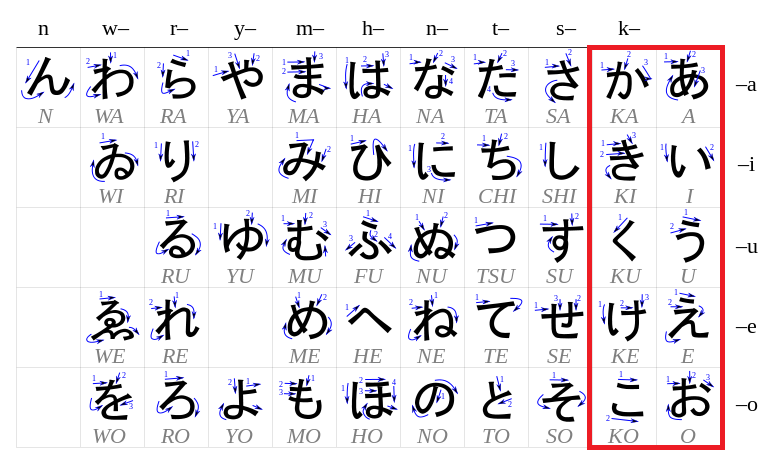Overview

In this lesson, we will be learning the first two columns of the Hiragana table (from right to left). We have to know how to pronounce each letter, how they are written and how they are represented in English (Also known as Romaji). As we look at each letter, try writing them out on a piece of paper. At the end of the lesson, I will give a brief explanation of long vowels, as well as example words that can be constructed from the letters you’ve just learnt.
Hiragana – First column
These are the 5 basic sounds, or vowels, of the Japanese language. Each image contains a letter, the order of strokes for writing the letter, and the Romaji associated with it. The pronunciation of each letter, as well as an audio clip, is below each letter.




Pronunciation: ‘Air’ (Without the r sound)
 Pronunciation: ‘Or’ (Without the r sound)
Pronunciation: ‘Or’ (Without the r sound)
Hiragana – Second Column
The letters in this column follow the 5 basic sounds that we’ve just learnt. They are pronounced by combining the corresponding phonetic sounds with these basic sounds. For example, the second column is associated with the ‘k’ sound, so the first letter in the second column, か, is pronounced as ‘kah’, and the second letter, き, is pronounced ‘kee’. The letters in the rest of the columns in the hiragana table also generally follow this system, although there are a few exceptions that I will point out in the future.
1.
2.
3.
4.
5.
Additional sounds
Certain letters can have two strokes added to the top and right to produce a different sound. For the ‘k’ column, adding the two strokes converts the ‘k’ sound to the ‘g’ sound. For instance, adding the two strokes to か makes it が, which is pronounced as ‘gah’.
- が
Romaji: Ga
- ぎ
Romaji: Gi
- ぐ
Romaji: Gu
- げ
Romaji: Ge
- ご
Romaji: Go
Long vowels
All 5 basic sounds can be extended to make a longer sound, by adding a vowel to the back. There are seven ways this can be done:
- ああ
- いい
- うう
- ええ
- えい
Note: This extends the E sound
- おお
- おう
Note: This extends the O sound
Not just the vowels can be extended, but any letter can be extended, depending on the vowel associated with it. For example, to extend こ, which is associated with お, you can either add another お to make it こお, or you can add う to make it こう.
Another thing to note is that there are two ways to extend え and お, but they both sound the same. It’s dependent on the word that contains the long vowel, and there isn’t really a pattern for which one to use.
Example words
Below are some words that can be formed by combining the letters we’ve just learnt.
- くうき (Kuuki) – Atmosphere
- かお (Kao) – Face
- うえ (Ue) – Above
- あおい (Aoi) – Blue
- あかい (Akai) – Red
- かぎ (Kagi) – Key
- がき (Gaki) – Brat
- こえ (Koe) – Voice
- きかく (Kikaku) – Plan
- いい (Ii) – Good
Conclusion
This has been a pretty long lesson, so I hope you’ve managed to stick with me so far. Try to practice writing out the hiragana characters so that you’ll be able to recognize them. It is good to take note of the example words, and perhaps you can recognize some of them in the example sentences when we start going through sentence structure.
Please drop a comment if you’re unsure of anything, and stay tuned for the next lesson on the next two rows of the Hiragana table.
Special thanks to edowin for voicing all the Japanese sounds!

I conceive this web site holds some real superb information for everyone : D.
magnificent post, very informative. I’m wondering why the opposite experts of this sector do not realize this.
You should proceed your writing. I am confident,
you’ve a huge readers’ base already!